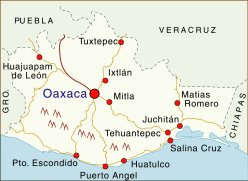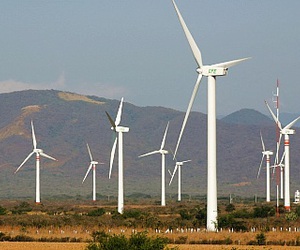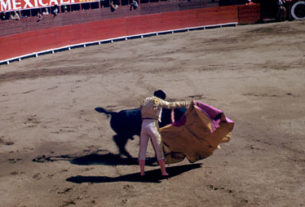The Months of Mexico

The tehuano endlessly blows where North America stops. The tehuano, the unforgiving forever wind of the Isthmus of Tehauntepec, ceaselessly scours a path through the wide gap where the continent of North America ends and Central America starts.
We entered this maelstrom upon leaving Highway 200 and departing the State of Oaxaca on one of our journeys to Chiapas and beyond. With a boisterous gale at our heels, we were swept giddily into Chiapas after a crazy, strangely enjoyable transit of the Isthmus of Tehuantepec where the truculent tehuanos are funnelled from the Gulf of Mexico, eventually to expire their restless sighs into the Pacific Ocean, beyond the turbulent boil of the Gulf of Tehuantepec.
This narrow neck of land joining the Atlantic to the Pacific — once a candidate along with Panama for a deep sea canal — is about 35 miles from north to south. A broad plateau formed upon the termination of the Sierra Madre Occidental range on its western flank, it comprises primarily Oaxaca and Veracruz States, including small portions of Chiapas and Tabasco. Geographically it separates North America from Central America.
The trade winds blow year-round at an average of 19 miles per hour, although at times, primarily during the winter months, they attain fierce velocity for days on end, particularly upon the clash of low and high pressure systems in the Gulf of Mexico. The wind direction is unvarying: north to south the winds range, emptying in unruly fashion beyond the Gulf of Tehuantepec. Wherever they are, they create a stir.
Small ship sailors heading towards the infrequently visited islands of the Pacific Costa Rica hunker down in Acapulco or Puerto Escondido waiting for a window of opportunity to begin a dash across the gulf. If they guess wrong or tarry too long at sea they place themselves at risk, for these mischievous mistrals — naughtily dubbed TehuantePeckers — would throw up fierce, short seas and rip seams from sails or try to capsize a boat which recklessly carried too much sail.
From nearby Highway 200, a cliff-hanging black ribbon of asphalt, we approached the Gulf of Tehauntepec and were roughly treated by the perverse heralds of the tehuano, and far out on the ruffled sea we could observe the effect of the wind. This highway — which commences in Tepic, Nayarit, 2,200 kilometres to the west, and terminates at Tapachula, near the Guatemala frontier — must be one of the great adventure roads of the world. It takes the traveller these 1,300 miles through plain, forest, jungle, desert and along many a tortuous track up mountain ridges and down to sea level on innumerable ascents and descents.
During several trips along much of this road and, in this single year, all of it, we found Highway 200 to be exhilarating because of its variety and teasing vistas, yet frustrating because of its occasional congestion and disrepair. Its setting makes it at once glorious and menacing.
And for much of its length, it parallels the Pacific Ocean which, although mostly inaccessible, save for by boot or burro, beckons by its beauty an invitation to the traveller. On the right lies the azure and vast ocean, while on the left sprawl mountain ranges tumbling over and over into the distance. They are equally tantalizing, but they are even less accessible and unwelcoming. The grey-green hills of Oaxaca roll on in succession in seeming isolation from the tread of humans, although on occasion the whiteness of a narrow road is exposed, shimmering in the sun’s midday haze, seeming to flutter in the high air, twisting and writhing in a pencil-thin, scrawled line to some place unknown and forbidding to us yet comforting and welcoming to its inhabitants.

It leads, one supposes, to a far-off hidden village where people strange to our ways deport themselves as though they were of another land and, for us wondering foreigners, they might just as well be aliens. We are drawn to the mystery of such places, but do not often seek out the road beyond the known horizon. We cling to our cliff-side road where, in our metal and fibreglass cocoons, we take some comfort in the familiarity of our North American customs, even though we soon will depart the geographic confines of the continent.
After the crossing of the Isthmus, the long-suffering, much buffeted Frida — our ever present Westfalia land yacht named after the artist Frida Kahlo, herself a breezy countenance — found us at a rundown hotel in Arriaga, just over the border in Chiapas. When we arrived at the lobby, the clerk seemed surprised to see us; we would be his only guests that night in a hotel with about 100 rooms.
Arriaga has not earned a place of prominence on glossy tourist brochures.
For 200 pesos, we could have a parking space with a distant electrical outlet located around the corner and farther along around yet another corner and, finally, over a 15-foot wall about 50 metres from our assigned parking slot, with no water and no guarantee that a starving mongrel would not seek refuge under our van, moaning and groaning the whole night long, engaged in some nightmare doggie drama enlivened by the dreadful, dark howl of the tempest. For an extra 50 pesos we could have a room with double bed, television, hot water shower, overhead fan and an opening window overlooking a couple of trees weighed down with mangos the size of grapefruit. And no dogs beneath the mattress.
We took the room. After cooking our evening meal in the van we tucked into bed early, excited to be in Chiapas and eagerly anticipating the events of the morrow.
Best of all, we would be out of the relentless wind, which even in the sheltered hotel compound whistled and twirled, sending up dust devils laden with discarded plastic bags, foam cups and cigarette butts, accompanied by more-biodegradable detritus such as seeds, leaves and fallen twigs. All of these were spun around as though immersed in a dance of a dervish, until they encountered a concrete wall over which they gaily slithered and sped on down the street, seeking — I imagined — to collect a few spindly-legged street dogs and offer them up to a dust deity in the sky. With the onrush of another gust, this spin cycle would be repeated, compliments of the Gulf of Mexico and this great gash between the mountains of Oaxaca and Chiapas.
The hotel clerk, a lawyerish, bespectacled man of middle years wearing pressed brown trousers and a light shirt buttoned up to his throat, assured me with a firm nod that these winds crossing the isthmus were a constant presence, occurring year-round with just brief periods of relief, usually coming in bursts of two to five days, then offering a brief respite before swooping down again, as constant as the squeals of the conveyor belt disgorging tortillas down the street. He assured me that they often were dangerous, threatening vehicles that had no other way of getting the approximate 200 kilometers from the city of Tehuantepec eastward to Arriaga. He said that trucks sometimes were overturned — he wove a tumbling motion with his hands to show how they would be tossed topsy-turvy into the ditches of the narrow roads. As he spoke, I watched an old man, bent double, pushing his bike against a press of wind in the street.
People driving large RVs had warned me about this stretch of road, relating stories of these encumbered behemoths being pushed off the road, of how the person at the wheel constantly had to fight against the unrelenting pressure of the wind and be ever fearful of the inevitable gust that would seek to seize the RV and fling it aside. If unlucky, the occupants would find themselves being thrown deep into a ravine, or into other traffic.
Even for autos and vans such as ours, these winds engender a sense of unease mixed with awe. They seem to advance from another world, one in which we do not exist, or where we are aliens to be teased and taunted. In this howling torment, we are unveiled as insignificant creatures, subject to the whims of a force which reveals the frailty of our self assurance.
At times, the wind had an uncontrolled violence to it. The trees and shrubs that had been able to survive the continual onslaught had long since been tamed: they leaned in one direction without exception, as if by the instruction of their genetic identity they had been born to bend. When a gust struck they whipped about in frenzy, dancing wildly, bowing and elastically rebounding as through under a dreadful spell to never stop.
Strangely there was no dust in the air; the landscape long since had been scrubbed clean, although bits and pieces of leaves, small branches and grass chaff swirled about. At times, I imagined a great gust over by Veracruz on the Gulf of Mexico, where big winds blow as well among the oil rigs, gathering up vast quantities of sand from the beaches of the gulf and, wielding them somewhat like huge flexible sheets of sandpaper, scouring mercilessly at this blighted corridor of rock and scrub. It is a great shoulder of wind, against which resistance is a mighty task, and vanguishment impossible.
With deep breaths of relief, the next day we were spat out of this tumult and hastened towards the mountains of Chiapas.

